In this article, Let’s explore how to bend water with Static Electricity. We wanted to try this experiment as part of our static electricity activities.
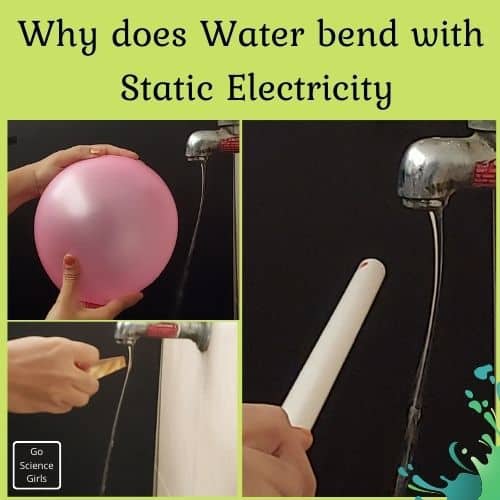
Hypothesis
Using a negatively charged plastic comb, a balloon or PVC pipe we can bend a water stream due to the positive charge in water.
Bending Water Science Experiment using Plastic Comb.
Materials Required
1) An Indoor Water Facet
2) A dry Plastic Comb
3) Someone’s dry and washed hair
4) Styrofoam Cups
Simple Step-by-Step Instructions
Step-1: Reach to one of your indoor facets that hold a good water supply and switch on the faucet. Make sure you are turning on a thin stream or flow of water out of the facet.
Step-2: Now, pick a plastic comb or Styrofoam cup and rub it against someone’s dry hair.
Step-3: Then, immediately bring whatever object you rubbed close to the flowing water stream. Keep in mind that you are not touching the water.
Step-4: Observe what is happening when the plastic object is brought near to the flowing water.
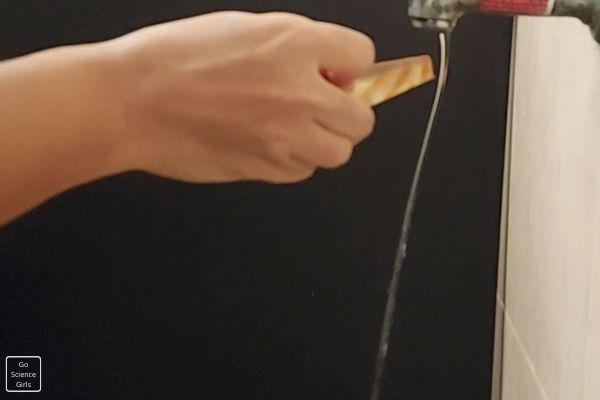
You will notice water bending towards the object that is rubbed against dry hair.
You might be interested in checking our other Static Electricity Experiments
Bending Water Science Experiment using a Balloon
Step-1: Take a medium-size balloon and blow it using an air blower or with your mouth. And tighten its mouth using a thin string such that the balloon does not deflate while experimenting.
Step-2: Switch on the water faucet and let it flow in a thin stream. Be sure the water flow is continuous, and maintain a very thin stream as much as you can.
Step-3: Now, take the inflated balloon into your hands and rub it against a woolen cloth or hair for a minute.
Step-4: And immediately bring the balloon near the water stream from the faucet.
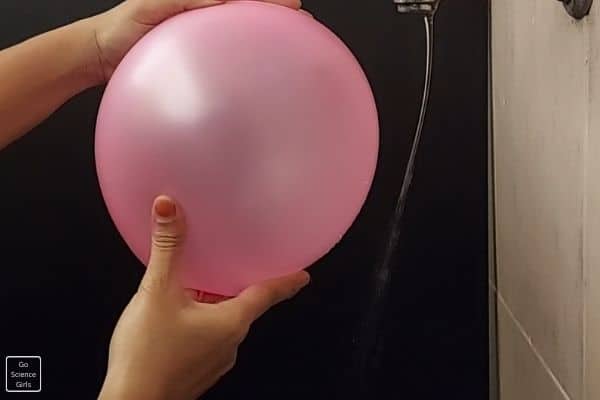
Then, observe the magical bending water stream. If you fail to bend the water stream in the first attempt, then rub the balloon against the woolen cloth once again for some more time and bring it close to the water stream.
Bending Water Science Experiment using PVC Pipe
Step-1: Take a feet length of PVC pipe and rub it against woolen cloth.
Step-2: Now, turn on the water faucet and allow 1-2 mm of the stream.
Step-3: Then, bring the PVC pipe soon close to the thin water stream.
Step-4: Observe how the PVC pipe is bending the water stream magically.
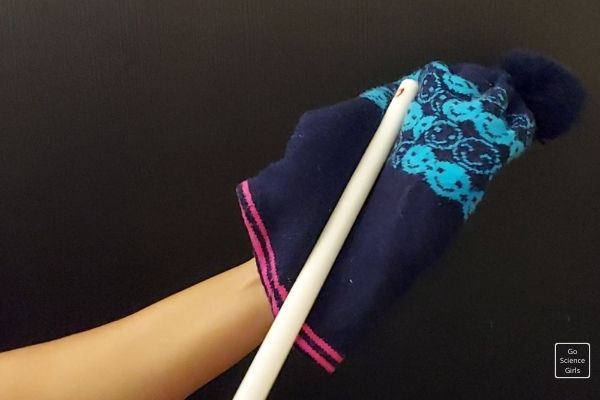
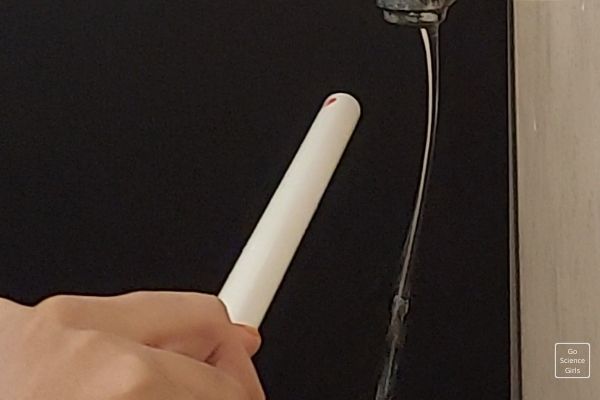
Note: If you fail to bend water, you need to rub your object (PVC pipe or Inflated balloon or Plastic comb) for some more time against dry hair or woollen cloth. Such that you will see the bending water.
What is the science behind bending water science experiments?
Any matter possesses an electric charge that encompasses a particular number of protons and electrons. Well, protons carry +1 electric charge and are limited to atoms’ nucleus, whereas electrons carry -1 electric charge, which is free to flow from one matter to another.
These electric charges are arbitrary. The existence and flow of these electric charges from one matter to another result in a phenomenon known as electricity.
Electricity is differentiated into two types. 1) Current Electricity and 2) Static Electricity
Current electricity is the electricity produced by electric charges across the electric field with a conductor. Static electricity is the electricity produced by friction caused when two or more objects are rubbed.
In this experiment, we are generating static electricity by rubbing plastic objects against human hair.
The flow of static electricity happens only when there is an equal amount of protons and electrons on the surface or within the two solid materials.
When the two solid objects rubbed against each other, free electrons, i.e., negatively charged ions jump from one object to another adjacent object making it negatively charged, whereas the losing object remains positively charged.
However, the amount of electricity produced depends on the number of electric charges accumulated and free flow from one object to another. In our experiment, dry hair is the best electric charge acquiring object when rubbed against other objects.
Let us apply the same science to the television in our home. What do you think the reason could be behind TV cabin receives less dust than TV screen? When the TV is switched on, the electrons flow from the back end to the main screen—these electrons on the screen cause it to charge. Any charged object attracts tiny particles such as dust. So, the charged screen attracts dust in a higher amount compared to the non-charged television cabinet.
Similarly, the object (comb or inflated balloon or any plastic material like PVC pipe) rubbed against human hair collects the free electrons or tiny charged particles. And as these electrons are negatively charged, the comb or any other plastic material becomes negatively charged. Hence, they attract positively charged objects.
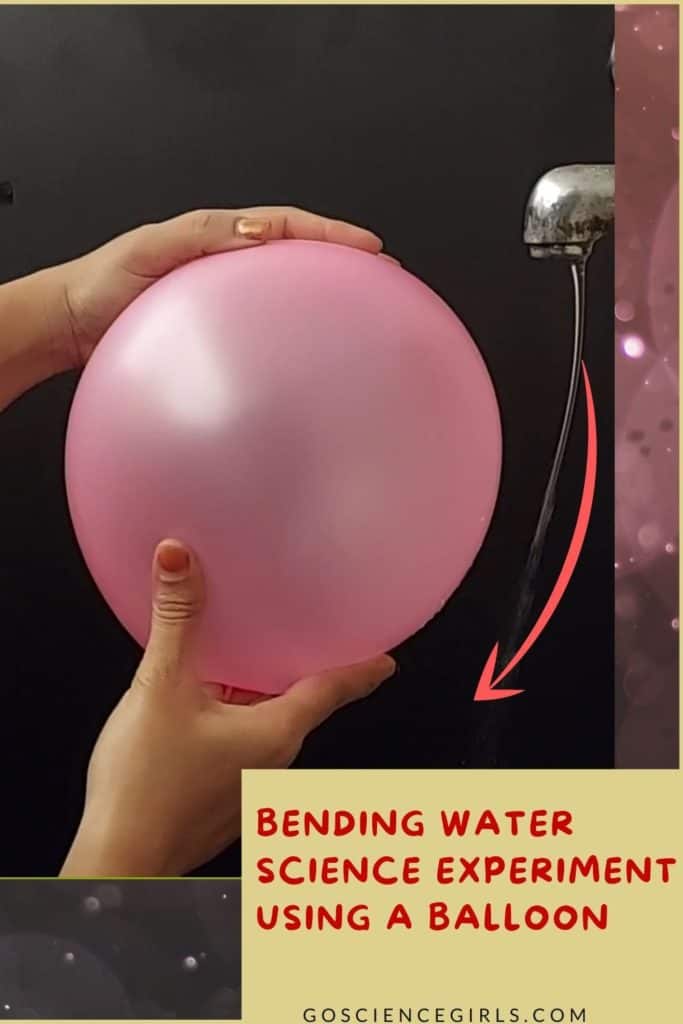
Water shows neutral electric charges as it encompasses an equal number of protons and electrons. But when the negatively charged object comes in close contact, the matching ions repel each other and move away from the object, pushing the positively charged ions in front. Hence, water emits positive force when a negatively charged object comes in close contact.
We can represent this as magnetism because even the magnets attract each other when there are two opposite poles meet. Since there is enough force to drag the thin water flow, the water stream shows little movement when a negatively charged object comes in close contact.
Experiment Extension Tips
You can try the same experiment using different methods and objects. For example:
1) Take nylon or latex-made objects and rub them against dry human hair or woollen cloth. Now, bring it near the thin flow of water faucet. Observe how amazingly the water stream moves and reveals the presence of static electricity.
2) Pick a piece of tissue paper and cut it into tiny pieces as small as you can. Then, take a comb or balloon and rub it against your dry hair. Then, see the magical movement of tiny tissue papers towards the comb or balloon.
In this way, you can try different objects that are readily available around your home and experience the wonders of static electricity.
Questions Part while or after the experiment
Let us see what those critical questions to be discussed during, and after the bending water science, experiment!!
1) Are there any other objects apart from the comb in the home that exhibits static electricity?
2) How temperature affects the bending of water action?
3) In what way, cold and dry hair impacts the development of static electricity?
4) What kind of impact does the moisture in the air affects the static electricity?
5) How does air flow or movement or moisture in it impacts the bending of water?
6) What do you think about the materials used to make comb or other plastic objects used in the experiment impact static electricity production?
7) Is there any difference in the amount of water flow from the faucet in producing static electricity?
8) Does the type of water flowed from the faucet change the flow and speed of static electricity?
9) What are other objects that produce or more likely to produce static electricity?
10) How magnetism and gravity help in producing static electricity in this experiment?
Bending Water Experiment Worksheet
Here are some worksheets that you can use to revise the concepts learned in this experiment.
These worksheets are best suitable for KS 3 -5 children.
https://www.csub.edu/chemistry/_files/Water%20bending%20Static%20ElectricityAO.pdf
Lesson Plan
Here are the best lesson plan ideas for teaching students about static electricity and bending water experiments. Just follow our tips and techniques on how to teach students about water and static electricity.
https://www.uwa.edu.au/science/-/media/Faculties/Science/Docs/Teacher-Guide—Static-electricity.pdf
FAQ’S
Absolutely, yes! Because water itself exhibits electrical charges with two hydrogen atoms and a single oxygen atom. However, hydrogen atoms encompass positive charge, and oxygen atom contains negative charge on them.
As water is in a liquid state, there is a free flow of electrical charges, which eventually affects the static electricity produced.
No, the water temperature does not show any difference in producing static electricity and bending water.
Because the production of static electricity happens only based on the number of free electrons, move from one object to another but not on the water’s temperature.
When you rub the balloon against your hair, the balloon becomes negatively charged. When a negatively charged balloon comes closer to the water stream, the likely charged ions move away and remain positively charged ions.
These positively charged ions are more likely to negatively charged balloon and starts bending the water.
Experiencing static electricity is common everywhere in our homes. If you are looking to get rid of it, then follow the below tips:
1) Install a tabletop humidifier in all the rooms
2) Use fabric softeners and dryer sheets to reduce the static electricity on your clothes
3) Be sure your home contains indoor plants in all rooms because some indoor plants increase the room’s humidity levels and reduce static electricity.
4) Treat your synthetic carpets and rugs with anti-static spray to prevent electric charges build up.
There are many ways to neutralize static electricity. Here are some:
1) Use dryer sheets for clothes to neutralize the charges build upon them
2) Apply moisturizers on the skin to balance the charges developed on the skin
3) Use hair spray for neutralizing charges on hairs
4) Freeze your garments to offset static electricity
5) Use misty hands if you want to touch charged objects
Static electricity is everywhere during winter months because there is dry air during colder months, making the accumulation of free electrons on skin and hair. That is why humans feel tiny electric shocks when they touch any negatively charged objects like woolen bed sheets, other persons, etc.
Rub your two hands against each other up and down and bring them closer to the water faucet. You will notice there is slight movement in the water stream. But make sure you drop down a very thin stream of water and dry hands. The negatively charged electrons build up on the hands when rubbed against each other attracts the positive force of water when brought closer to it. In this way, our hands produce static electricity and bend water.
